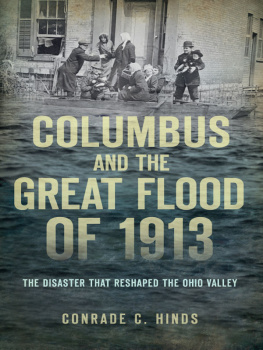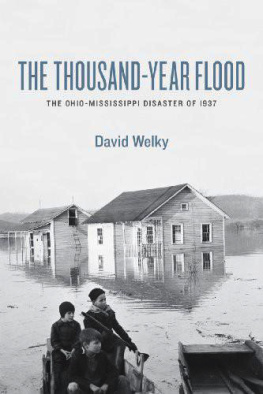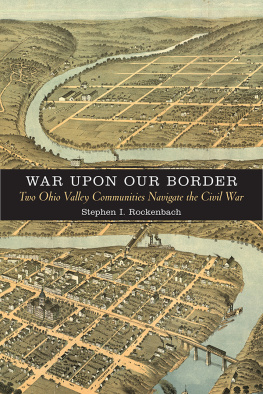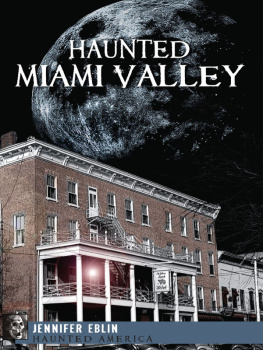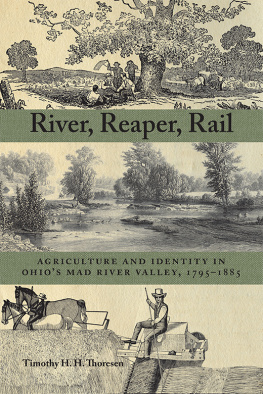Preface
THIS IS A STORY OF THE CATTLEMEN IN THE OHIO VALLEY. IT does not concern itself (beyond some mention in the first chapter) with explorers, soldiers, or politicians, as such, although some of the cattlemen were one or another of these. Seven chapters attempt to tell how the settlers occupied the valley, bred cattle, grazed and fed them, drove them to market, and sold them. The first chapter tells of the occupation of the Ohio Valley; the concluding chapter finds the cattlemen looking west again, this time to Missouri and the plains.
I first became interested in the theme of this book through my study of cattle driving from the Ohio country (Agricultural History [April, 1954], 28:83-95). When I became aware of the great importance the beef-cattle industry once had in the Ohio Valley, I saw in this larger story an opportunity to study a much-neglected subject. Popular opinion associates the beef-cattle industry with the trans-Mississippi West and seems to assume that this great industry was born full grown; but much of the later business had its antecedent in the Ohio Valley, where also many of the Texas cattlemen received their first introduction into the lore of cattle raising.
The geographical area of my study is arbitrarily limited. The subject is a cattle kingdom bestriding the Ohio River and centering in the Kentucky Bluegrass and the valleys of the Scioto, Miami, Wabash, and Sangamon rivers in Ohio, Indiana, and Illinois. It does not include the Nashville Basin, although this drains into the Ohio; but it does include parts of the present Corn Belt. The upper Ohio Valley was not really a part of this kingdom, for beef cattle had little commercial importance in western Pennsylvania or in the vast stretch of mountainous country between the Big Levels of western Virginia and the Kentucky Bluegrass, although at an early date some high-class cattle were produced around Clarksburg and Kingwood, both in the sources of the Monongahela, and in the bluegrass pastures between Weston and Elkins.
Unfortunately, it was already late to attempt to piece together the story. The documentary remains were dwindling, and sections of the story were passing into tradition or folklore. For example, several years ago the farmhouse of the Kentucky Renicks burned to the ground, engulfing in flames crates of papers of old Abe Renick, the important and picturesque cattle breeder. I was told by a friend who used to live in Pick-away County, Ohio, that a collection of manuscripts relating to the cattle industry along Deer Creek was destroyed a few years ago by children who cut them up with scissors to make paper dolls. Although the United States is a young country endowed with a relatively large quantity of manuscript records, time waits for no man, historian or other.
Locating manuscript records is a difficult problem for the agricultural historian. I had the good fortune to meet four persons who had manuscripts, hitherto unexamined, and who took a genuine interest in my project. I wish especially to acknowledge the enthusiasm of these four persons. They are Renick Cunningham, to whom I am indebted for making available to me all the Felix Renick papers in his possession; Joseph I. Vanmeter, to whom I am obliged for scouring his study and finding several Vanmeter and Vause items; Cassius M. Clay, to whom I am grateful for opening to me the voluminous Brutus Clay papers; and Ben Douglas Goff, Sr., to whom I am indebted for letting me borrow the Strauder Goff papers.
Andrew H. Clark, whose inquisitiveness and enthusiasm are contagious, helped conceive the idea of this as a book-length subject.
Vernon Carstensen, my thesis adviser, has brought to the subject his own knowledge of agricultural history, has provided encouragement and ideas, and has gone over the drafts of the manuscript tirelessly and patiently.
Lucien Beckner, who had written Kentuckys Glamorous Shorthorn Age (Filson Club History Quarterly [January, 1952], 26:37), called upon his intimate knowledge of Kentucky to think up sources.
Edward N. Wentworth shared with me his long experience in livestock history and prepared a criticism of portions of my manuscript.
A research grant from the Graduate School of the University of Wisconsin enabled a years study of the cattle driving, a study originally proposed by Professor Vernor C. Finch of the geography department.
The librarians of the University of Kentucky manuscript room, the Filson Club, and the Philosophical and Historical Society of Ohio (Cincinnati) have left no stone unturned in summoning the resources of their places to my assistance.
This study is offered as an extension of the work already done by James Westfall Thompson and Charles T. Leavitt. But the study of the beef-cattle industry needs to be filled out with studies of it in the upper South (Virginia, North Carolina, and Tennessee) and after it moves into Illinois, Missouri, and Iowa. This latter project would tie together the work already done by Helen Cavanagh, Paul W. Gates, Clifford Carpenter, John Ashton, Edward N. Wentworth, and others.
Paul C. Henlein
Chapter 1
Establishing the Industry
THE OHIO VALLEY BEGINS, TECHNICALLY, AT THE WATER DIVIDE in the Appalachian Mountains. But the range after range of mountains tumbling away to the west blocked off a clear picture of the great valley. The awareness of that valleythe land promised by the brochures of the land companies and later glorified by Thomas Hart Benton as the Garden of the Worldcame to different men at different points as they approached the valley. It came to Daniel Boone and John Finley in 1769 as they stood on Pilot Knob, an escarpment rising 800 feet over the undulating Bluegrass Basin; to many of the Virginians and most of the Carolinians when they reached Big Hill Gap, on Boones original trace, or drew near to Crab Orchard, on the Wilderness Road; to George Renick in 1793 as he rode along the Great Kanawha down past Charleston and suddenly saw the steep hills fold back from the riverbank and reveal the valley. To the Pennsylvanians who were emigrating overland and to a sprinkling of South Branch Virginians who had struck out for Wheeling and Zanesville, it occurred at some nameless hill on Zanes Trace between Lancaster and the present Kinnickinnick, a nameless hill where the emigrant caught his first glimpse of the gently rolling landscape of prime soil leading to the wide floodplain of the Scioto; and as a back-backdrop, Horseback Knob, the last outrider of the Alleghenies.
As Boone and Finley gazed westward from Pilot Knob, they probably were unaware of the significant soil boundary concealed beneath the forest canopy: that between the shale-based soils of the eastern Kentucky mountains and the limestone-based soils of the Kentucky Bluegrass. The latter, with the limestone soils of the Scioto and Miami valleys, the Tipton Till of Indiana north of Indianapolis, and the deep-loess prairie soil of Illinois, formed the soil setting for the cattle-feeding industry in the Ohio Valley.



